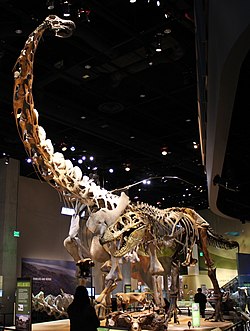Alamosaurus
Alamosaurus was a titanosaur, a gigantic plant-eating dinosaur from the Upper Cretaceous period, about 73 million to 65 million years ago.
| Alamosaurus Temporal range: Upper Cretaceous
| |
|---|---|

| |
| Restored skeletons of Alamosaurus and Tyrannosaurus at Perot Museum | |
| Scientific classification | |
| Kingdom: | |
| Class: | |
| Superorder: | |
| Order: | |
| Suborder: | |
| Infraorder: | |
| Family: | |
| Subfamily: | |
| Genus: | Alamosaurus
|
Alamosaurus was a long-necked, whip-tailed dinosaur. It was about 69 feet (21 m) long and weighed perhaps 33 tons (30000 kg). Fossils have been found in New Mexico, Texas, and Utah. Fossils include fragmentary skeletons (and no skulls).
Skeletal elements of Alamosaurus are among the most common Late Cretaceous dinosaur fossils found in the United States Southwest and are now used to define the fauna of that time and place. There was a climate change in this area, it became drier, and this caused changes in the fauna. Thomas M. Lehman describes it as "the abrupt reemergence of a fauna with a superficially 'Jurassic' aspect".[1] These faunas are dominated by Alamosaurus and feature abundant Quetzalcoatlus in Texas.[1] The Alamosaurus – Quetzalcoatlus association probably represent semi-arid inland plains.[1]p201
Alamosaurus Media
Size of North American titanosaur specimens compared to a human, including the Alamosaurus (third silhouette) and Utetitan (second silhouette) holotypes
Speculative life restoration
Restoration of Alamosaurus (background) and other dinosaurs from the Ojo Alamo Formation






